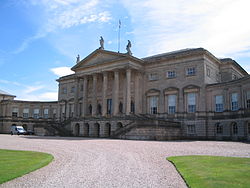Quadrant (architecture)

Quadrant in architecture refers to a curve in a wall or a vaulted ceiling. Generally considered to be an arc of 90 degrees (one quarter of a circle), or a half of the more commonly seen architectural feature (a crescent).
The quadrant curve was a feature popularised by Andrea Palladio, who used it often for the wings and colonnades which linked his classical style villas to their service wings and outbuildings. However, curved quadrant buildings should not be confused with the canted facades of Baroque architecture or the slightly curved buildings of the era such as the Quattro Canti in Palermo.
The quadrant vault, a feature of
During the 18th century, the quadrant once again became a popular design shape for the terraces of smart houses in fashionable spa towns such as Buxton. Henry Currey's "Quadrant", built to rival the architecture of Bath, is considered one of Buxton's finest buildings.
References
- Jackson-Stops, Gervase (1990). The Country House in Perspective. Pavilion Books. ISBN 1-85145-383-0.
- A Working Glossary of Architectural Terms,Techniques and Structural Elements retrieved 17 October 2007
